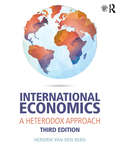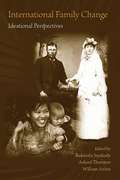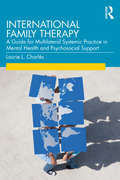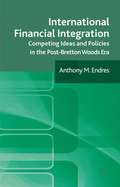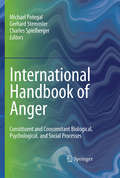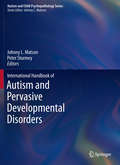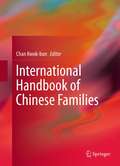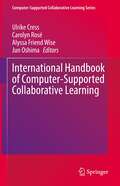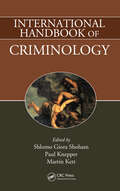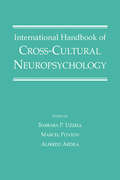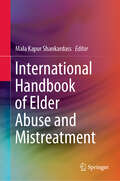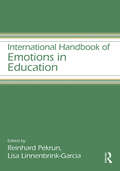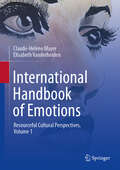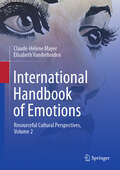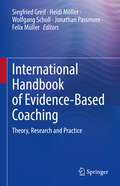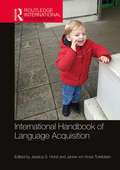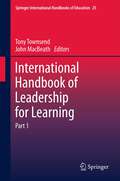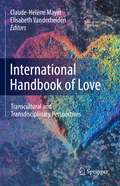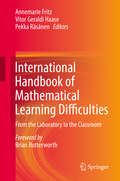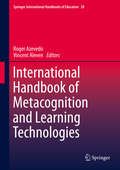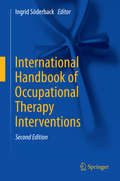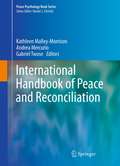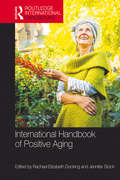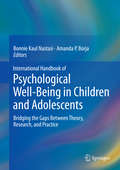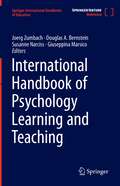- Table View
- List View
International Economics: A Heterodox Approach
by Hendrik Van BergNow in its third edition, Hendrik Van den Berg’s International Economics: A Heterodox Approach covers all of the standard topics taught in undergraduate international economics courses. Written in a friendly and approachable style, this new edition is unique in that it presents the key orthodox neoclassical models of international trade and investment, while supplementing them with a variety of heterodox approaches. This pluralist approach is intended to give economics students a more realistic understanding of the international economy than standard textbooks can provide. Changes to the new edition include: updates throughout to reflect recent world events, including coverage of trade negotiations and the Greek crisis; expanded discussion of pluralist approaches with more coverage of alternative schools of thought; discussions of the growing financialization of global economic activity; additional real-world examples; increased coverage of environmental issues; transnational corporations and their behavior in the international economy; the difference between international investment and international finance; and monetary history; a consolidated and updated chapter on international banking. This book also maintains a broad perspective that links economic activity to the social and natural spheres of human activity, with emphasis on the distributional and environmental effects of international trade, investment, finance, and migration. Chapter summaries, key terms and concepts, problems and questions, and a glossary are included in the book. A Student Study Guide and an Instructor’s Manual are available online.
International Family Change: Ideational Perspectives
by Arland Thornton Rukmalie Jayakody William AxinnMany dimensions of family life have changed. Age at marriage has risen, arranged marriages and extended families have declined, intergenerational relationships have been altered, and contraceptive usage has become widespread. Until now, most explanations have focused on structural influences that emphasize changes in social and economic circumstanc
International Family Therapy: A Guide for Multilateral Systemic Practice in Mental Health and Psychosocial Support
by Laurie L CharlésInternational Family Therapy brings the international plane and its emphasis on the global community of states to systemic family therapy. Informed by a coherent, multilateral perspective, each chapter covers a specific topic, including: discussions on the basis of state sovereignty and the role of international human rights law; the concept of human security and psychosocial risk to vulnerable populations; and the international economics and trade of public mental health initiatives for families across the globe. Written in an accessible style and peppered with vignettes and descriptive case examples, the text encourages the reader to better understand and implement family systems approaches from the perspective of the international system, with a focus on cultural considerations and best practice throughout. Combining key theoretical tenets of family therapy and essential knowledge of international relations relevant to global mental health, International Family Therapy is an essential guide for family therapy practitioners interested in working internationally.
International Financial Integration
by Anthony M. EndresDrawing on prominent contributions by economists to the debate on international monetary reform, this book provides an historical perspective on the plans, schemes and ideas on the international financial system.
International Handbook of Anger
by Gerhard Stemmler Charles Spielberger Michael PotegalBook covers a broader range of topics than other books in this area. Notably, extensive coverage of the neurobiology of anger in context of psychology and sociology is unique. Book provides broad, integrative coverage while avoiding unnecessary duplication. Contributors have read each others' chapters and there is extensive cross-referencing from chapter to chapter. Book contains a guide to content and organization of chapters and topics, along with interpolated commentary at the end of each section.
International Handbook of Autism and Pervasive Developmental Disorders
by Johnny L. Matson Peter SturmeyBased on a solid historical foundation of autism theory and research, this inclusive handbook integrates coverage of the broader scholarly literature with a trenchant analysis of the state of the field in nosology, etiology, assessment, and treatment.
International Handbook of Chinese Families
by Chan Kwok-BunFamilies are the cornerstone of Chinese society, whether in mainland China, in Taiwan, Hong Kong, Macao, Singapore, Malaysia, or in the Chinese diaspora the world over. Handbook of the Chinese Family provides an overview of economics, politics, race, ethnicity, and culture within and external to the Chinese family as a social institution. While simultaneously evaluating its own methodological tools, this book will set current knowledge in the context of what has been previously studied as well as future research directions. It will examine inter-family relationships and politics as well as childrearing, education, and family economics to provide a rounded and in-depth view.
International Handbook of Computer-Supported Collaborative Learning (Computer-Supported Collaborative Learning Series #19)
by Ulrike Cress Alyssa Friend Wise Carolyn Rosé Jun OshimaCSCL has in the past 15 years (and often in conjunction with Springer) grown into a thriving and active community. Yet, lacking is a comprehensive CSCL handbook that displays the range of research being done in this area. This handbook will provide an overview of the diverse aspects of the field, allowing newcomers to develop a sense of the entirety of CSCL research and for existing community members to become more deeply aware of work outside their direct area. The handbook will also serve as a ready reference for foundational concepts, methods, and approaches in the field. The chapters are written in such a way that each of them can be used in a stand-alone fashion while also serving as introductory readings in relevant study courses or in teacher education. While some CSCL-relevant topics are addressed in the International Handbook of the Learning Sciences and the International Handbook of Collaborative Learning, these books do not aim to present an integrated and comprehensive view of CSCL. The International Handbook of Computer- Supported Collaborative Learning covers all relevant topics in CSCL, particularly recent developments in the field, such as the rise of computational approaches and learning analytics.
International Handbook of Criminology
by Paul Knepper Shlomo Giora Shoham Martin KettThe second handbook in the Shoham trilogy, which includes the esteemed International Handbook of Penology and Criminal Justice and the upcoming International Handbook of Victimology, this volume is a comprehensive treatment of criminology theory. This text contains contributions from 25 of the top international scholars in the field across a wide range of disciplines. Topics include social deviance, research methods, biological and physiological explanations, personality types, and family socialization processes. The book also explores ecological and economic factors, differential association and situational crime prevention, cultural conflicts and immigration, as well as stigmas, group delinquency and juvenile delinquency.
International Handbook of Cross-Cultural Neuropsychology
by Alfredo Ardila Barbara P. Uzzell Marcel O. PontónThe role of culture is significant when measuring cognitive abilities during neuropsychological assessments. However, cultural diversity is a frequently overlooked moderating variable. The International Handbook of Cross-Cultural Neuropsychology emphasizes major distinctions among cultural groups in North and South America, Europe, Africa, Asia, an
International Handbook of Elder Abuse and Mistreatment
by Mala Kapur ShankardassThis first-of-its-kind work on elder abuse and mistreatment provides a comprehensive and up-to-date overview of the subject. Covering almost all regions of the world, it highlights different dimensions of elder abuse and mistreatment in terms of their prevalence, incidence, prevention, treatment, management and response from governments and civil society, academic and research communities, and society in general. Written by international specialists from various disciplinary and presenting the latest findings and data, the handbook includes sections on the Americas; the Caribbean; Europe; Central, West and South Asia; East Asia and Asia-Pacific; and Africa. The chapters offer clarity on the concept and forms of elder abuse and neglect, discuss research methodology, and provide policy options, legislative solutions and programmatic responses to give relief to older people as victims of abuse and neglect as well as to deal with the perpetrators. This book is intended for a wide range of students and researchers interested in aging, from sociology, to social work, community medicine, public health, clinical psychology, and human rights/law.
International Handbook of Emotions in Education (Educational Psychology Handbook)
by Reinhard Pekrun Lisa Linnenbrink-GarciaFor more than a decade, there has been growing interest and research on the pivotal role of emotions in educational settings. This ground-breaking handbook is the first to highlight this emerging field of research and to describe in detail the ways in which emotions affect learning and instruction in the classroom as well as students’ and teachers’ development and well-being. Informed by research from a number of related fields, the handbook includes four sections. Section I focuses on fundamental principles of emotion, including the interplay among emotion, cognition, and motivation, the regulation of emotion, and emotional intelligence. Section II examines emotions and emotion regulation in classroom settings, addressing specific emotions (enjoyment, interest, curiosity, pride, anxiety, confusion, shame, and boredom) as well as social-emotional learning programs. Section III highlights research on emotions in academic content domains (mathematics, science, and reading/writing), contextual factors (classroom, family, and culture), and teacher emotions. The final section examines the various methodological approaches to studying emotions in educational settings. With work from leading international experts across disciplines, this book synthesizes the latest research on emotions in education.
International Handbook of Emotions: Resourceful Cultural Perspectives, Vol. 1
by Elisabeth Vanderheiden Claude-Hélène MayerThis two-volume handbook reimagines the role of emotions, offering transformative insights into their significance for individuals, communities, and societies. Volume 1 combines rigorous theoretical exploration, personal narratives, and cutting-edge research to explore the intricate connections between emotions, human development, and positive psychology. Far beyond the confines of emotional well-being, this volume examines the transformative power of emotions in shaping identities and driving personal and collective growth. Through its comprehensive approach, it paints a vivid picture of the human emotional experience while navigating diverse cultural contexts and intergenerational dynamics. This work challenges conventional approaches by integrating perspectives from various cultural backgrounds and cross-cultural experiences, offering readers a deeper understanding of how emotions influence relationships, decision-making, and societal change. It is an indispensable resource for psychologists, researchers, educators, and practitioners aiming to expand their knowledge of emotions in a global context and apply innovative frameworks in their work. Through its synthesis of theory and practice, the handbook invites readers to rethink the emotional dimensions of human experience. It encourages the exploration of new paradigms that highlight the transformative potential of emotions and their ability to shape inclusive and emotionally intelligent communities. This volume is more than a collection of knowledge—it is a call to action for those who seek to understand and harness the transformative potential of emotions. Whether exploring the role of emotions in culturally diverse and transcultural understanding or their impact on personal growth, this handbook opens new pathways for academic inquiry and practical application, redefining how we perceive and engage with the emotional fabric of our world. <span lang="EN-US" style="mso-fareast-font-family: 'Times New Roman'; mso-bidi-font-family: Calibri; mso-bidi-theme-font: minor-latin;
International Handbook of Emotions: Resourceful Cultural Perspectives, Vol. 2
by Elisabeth Vanderheiden Claude-Hélène MayerVolume 2 of this two-volume handbook extends the foundational understanding of emotional well-being through the lens of positive psychology into the realms of cultural diversity, societal impacts, and the influence of technology. This volume offers an in-depth examination of the societal impact of emotions, cultural interpretations, and the emerging significance of digital and robotic interactions with emotions. It encompasses a wide range of topics, including the effects of global crises on emotional well-being, the role of art and literature in understanding emotions, and the future of emotional intelligence in the age of digital technology. Studies featured in this Volume 2 provide insight into emotional experiences across diverse cultures, the resilience of immigrants and refugees, and the psychological dynamics of collective behaviour, alongside considerations of how technology is reshaping our emotional lives. The volume stands as a critical academic resource, enriching the discourse on the global and transcultural dimensions of emotional well-being. It highlights the pivotal role of cultural and technological considerations in advancing our understanding of emotions and sets a new benchmark for research and practice in the field. Aimed at scholars, researchers, and practitioners in psychology, cultural studies, and technological innovation, this volume also addresses educators, policymakers, and anyone with a keen interest in understanding the complex interplay between emotion, culture, and technology. By bridging gaps between disciplines, this volume fosters a more comprehensive and nuanced understanding of emotional well-being across different cultural contexts and technological environments. It prompts interdisciplinary dialogue, offering evidence-based insights for mental health practices, educational strategies, and policymaking. Emotion science has progressed enormously in the last decade. For those wishing to get insight into the depth and breadth of this progress, this is a terrific, edited 2 volume overview, brought together by two internationally recognised emotion researchers. It takes a biopsychosocial approach exploring the multiple dimensions of emotion science and how it can be applied to many different aspects of human life from therapy through to the organisation of communities. It will be a must have book for anyone interested in understanding the complexities of emotions.  
International Handbook of Evidence-Based Coaching: Theory, Research and Practice
by Jonathan Passmore Heidi Möller Wolfgang Scholl Felix Müller Siegfried GreifThis handbook comprehensively covers the fundamental key concepts in coaching research and evidence-based practice and shows how coaching can be applied to multiple contexts. It provides coaching scholars, researchers and practitioners with detailed review of the key concepts, research and new insights into coaching research and practice. This key reference work includes over 70 contributions from more than 110 leading researchers and practitioners in the field across countries, and deftly combines theory with case studies and applications from psychology, sociology, business administration, organizational studies, education, and communication studies. This handbook, edited by the top scholars in the field, is meant for an academic as well as a professional readership, and is an invaluable resource for coaches, clients, coaching institutes and associations, and students of coaching.
International Handbook of Language Acquisition (Routledge International Handbooks)
by Jessica S. Horst Janne von Koss TorkildsenHow do children acquire language? How does real life language acquisition differ from results found in controlled environments? And how is modern life challenging established theories? Going far beyond laboratory experiments, the International Handbook of Language Acquisition examines a wide range of topics surrounding language development to shed light on how children acquire language in the real world. The foremost experts in the field cover a variety of issues, from the underlying cognitive processes and role of language input to development of key language dimensions as well as both typical and atypical language development. Horst and Torkildsen balance a theoretical foundation with data acquired from applied settings to offer a truly comprehensive reference book with an international outlook. The International Handbook of Language Acquisition is essential reading for graduate students and researchers in language acquisition across developmental psychology, developmental neuropsychology, linguistics, early childhood education, and communication disorders.
International Handbook of Leadership for Learning
by John Macbeath Tony TownsendThe International Handbook of Leadership for Learning brings together chapters by distinguished authors from thirty-one countries in nine different regions of the world. The handbook contains nine sections that provide regional overviews; a consideration of theoretical and contextual aspects; system and policy approaches that promote leadership for learning with a focus on educating school leaders for learning and the role of the leader in supporting learning. It also considers the challenge of educating current leaders for this new perspective, and how leaders themselves can develop leadership for learning in others and in their organisations, especially in diverse contexts and situations. The final chapter considers what we now know about leadership for learning and looks at ways this might be further improved in the future. The book provides the reader with an understanding of the rich contextual nature of learning in schools and the role of school leaders and leadership development in promoting this. It concludes that the preposition 'for' between the two readily known and understood terms of 'leadership' and 'learning' changes everything as it foregrounds learning and complexifies, rather than simplifies, what that word may mean. Whereas common terms such as 'instructional leadership' reduce learning to 'outcomes', leadership for learning embraces a much wider, developmental view of learning.
International Handbook of Love: Transcultural and Transdisciplinary Perspectives
by Elisabeth Vanderheiden Claude-Hélène MayerTh is handbook includes state-of-the-art research on love in classical, modern and postmodern perspectives. It expands on previous literature and explores topics around love from new cultural, intercultural and transcultural approaches and across disciplines. It provides insights into various love concepts, like romantic love, agape, and eros in their cultural embeddedness, and their changes and developments in specific cultural contexts. It also includes discussions on postmodern aspects with regard to love and love relationships, such as digitalisation, globalisation and the fourth industrial revolution. Th e handbook covers a vast range of topics in relation to love: aging, health, special needs, sexual preferences, spiritual practice, subcultures, family and other relationships, and so on. Th e chapters look at love not only in terms of the universal concept and in private, intimate relationships, but apply a broad concept of love which can also, for example, be referred to in postmodern workplaces. Th is volume is of interest to a wide readership, including researchers, practitioners and students of the social sciences, humanities and behavioural sciences.In the 1970s through the 90s, I was told that globalization was homogenizing cultures into a worldwide monoculture. Th is volume, as risky and profound as the many adventures of love across our multiplying cultures are, proves otherwise. Th e authors’ revolutionary and courageous work will challenge our sensibilities and expand the boundaries of what we understand what love is. But that’s what love does: It communicates what is; offers what can be; and pleads for what must be. I know you’ll enjoy this wonderful book as much as I do!Jeffrey Ady, Associate Professor (retired), Public Administration Program, University of Hawaii at Manoa, Founding Fellow, International Academy for Intercultural ResearchThe International Handbook of Love is far more than a traditional compendium. It is a breath-taking attempt to synthesize our anthropological and sociological knowledge on love. It illuminates topics as diverse as Chinese love, one-night stands, teen romance or love of leaders and many more. Th is is a definitive reference in the field of love studies.Eva Illouz, author of Th e End of Love: A sociology of Negative relationships. Oxford University Press.
International Handbook of Mathematical Learning Difficulties: From the Laboratory to the Classroom
by Pekka Räsänen Annemarie Fritz Vitor Geraldi HaaseThis comprehensive volume provides teachers, researchers and education professionals with cutting edge knowledge developed in the last decades by the educational, behavioural and neurosciences, integrating cognitive, developmental and socioeconomic approaches to deal with the problems children face in learning mathematics.The neurocognitive mechanisms and the cognitive processes underlying acquisition of arithmetic abilities and their significance for education have been the subject of intense research in the last few decades, but the most part of this research has been conducted in non-applied settings and there’s still a deep discrepancy between the level of scientific knowledge and its implementation into actual educational settings. Now it’s time to bring the results from the laboratory to the classroom. Apart from bringing the theoretical discussions to educational settings, the volume presents a wide range of methods for early detection of children with risks in mathematics learning and strategies to develop effective interventions based on innovative cognitive test instruments. It also provides insights to translate research knowledge into public policies in order to address socioeconomic issues. And it does so from an international perspective, dedicating a whole section to the cultural diversity of mathematics learning difficulties in different parts of the world. All of this makes the International Handbook of Mathematical Learning Difficulties an essential tool for those involved in the daily struggle to prepare the future generations to succeed in the global knowledge society.
International Handbook of Metacognition and Learning Technologies
by Vincent Aleven Roger AzevedoIntegrating all aspects of the fields of metacognition and learning technologies, this book describes features of the learning technologies and how they have been designed to study and support metacognitive processing and self-regulated learning.
International Handbook of Occupational Therapy Interventions
by Ingrid SöderbackResources for rehabilitation specialists tend to follow a straight line: injury--disability--limitation--intervention. The International Handbook of Occupational Therapy Interventions breaks with this tradition, organized by type of intervention (based on recommendations in the International Classification of Functioning) rather than disability, medical condition, or level of impairment. This innovative, user-friendly system identifies candidates for particular interventions in terms of the range of syndromes and illnesses they are applicable to, encouraging critical thinking, problem solving, and best practice. The book's wide spectrum of interventions coupled with its international perspective creates a unique source of evidence-based strategies for improving patients' adaptation, functioning, relearning, recovery, and the prevention of ill health. The Handbook: Describes interventions in such areas as environmental accessibility, ergonomics, pain management, sensory functional training, electric prostheses, music therapy, psychoeducation, and cognitive teaching. Features interventions suited to all areas of daily life: self maintenance, home, work, and leisure. Clarifies the occupational therapist's role in multidisciplinary care. Includes material on accident/illness prevention and health promotion strategies. Supplies reference lists of studies regarding the clinical efficacy of interventions. Demonstrates the use of a common technical language for the field. Occupational and physical therapists, rehabilitation nurses and technicians, physiatrists, and health psychologists will find the International Handbook of Occupational Therapy Interventions a source of practice-enhancing tools and ideas. Its clarity of presentation makes it highly useful to readers in related fields (such as insurance case workers and ergonomic architects and engineers) as well.
International Handbook of Peace and Reconciliation
by Kathleen Malley-Morrison Gabriel Twose Andrea MercurioHow do ordinary people from different regions around the world define peace and reconciliation? What factors do they think are necessary for promoting reconciliation between countries? Do they believe that individuals have a right to protest against war and in favor of peace? Do they believe that apologies can improve the chances of reconciliation? What do they think are the best ways for achieving peace? Does reasoning regarding the achievability of world peace vary by region? International Handbook of Peace and Reconciliation, a companion volume to the International Handbook on War, Torture, and Terrorism, examines and analyzes how people around the world think about justice, governmental apologies, the right to protest, the peace process, the justifiability of armed conflict, the possibility of world peace, and reconciliation. To address these questions, researchers from the Group on International Perspectives on Governmental Aggression and Peace (GIPGAP) administered the Personal and Institutional Rights to Aggression and Peace Survey (PAIRTAPS) to volunteers from over 40 countries representing the major regions of the world. The volume is organized such that the responses to the survey are summarized and analyzed by both by country and by theme. Integrative chapters provide an up-to-date overview of historical and current events relevant to peace and reconciliation and a grounded theory analysis of definitions of peace and reconciliation and of the role of apology in reconciliation. In addition to describing the major themes emerging from the responses in each region, the volume reports on some exploratory analyses addressing the extent to which we found differences in patterns of responding based on characteristics such as gender, military experience, and involvement in anti-war protest activity. International Handbook on Peace and Reconciliation allows ordinary citizens from around the world to voice their views on peace and related issues, and examines the context of these views. Thus, it offers researchers in political science, peace psychology, social psychology, social justice, and anthropology a comprehensive resource for a changing global landscape.
International Handbook of Positive Aging
by Jennifer Stock Rachael E. DockingAs our global demographic shifts towards an increasingly aging population, we have an opportunity to transform how we experience and think about getting older and embrace the diversity and contribution that this population can bring to society. The International Handbook of Positive Aging showcases the latest research and theory into aging, examining the various challenges faced by older adults and the ways in which we can bring a much-needed positive focus towards dealing with these. The handbook brings together disparate research from medical, academic, economic and social community fields, with contributions from NHS partners, service users, universities across the United Kingdom and collaborations with international research leaders in the field of aging. Divided into sections, the first part of the book focuses on introducing the concept of positive aging before going on to cover the body over the life course, well-being and care delivery. All contributors recognise the fact that we are living longer, which is providing us with a tremendous opportunity to enjoy and flourish in healthy and fulfilling later lives, and this focus on the importance of patient empowerment is integral to the book. This is a valuable reference source for those working in developmental psychology, clinical psychology, mental health, health sciences, medicine, neuropsychological rehabilitation, sociology, anthropology, social policy and social work. It will help encourage researchers, professionals and policymakers to make the most of opportunities and innovations to promote a person’s sense of independence, dignity, well-being, good health and participation in society as they get older.
International Handbook of Psychological Well-Being in Children and Adolescents
by Bonnie Kaul Nastasi Amanda P. BorjaThis handbook addresses universal developmental and cultural factors contributing to child and adolescent mental health and well-being across the globe. It examines sociocultural contexts of development and identifies children's and adolescents' perspectives as critical to understanding and promoting their psychological well-being. It details the Promoting Psychological Well-Being Globally project's methodology for data collection and analysis, provides cross-cultural analyses of its findings, and offers a practical model for clinicians and other professionals seeking to apply this knowledge to real-life settings. Featured topics include: Sexual health, gender roles, and psychological well-being in India. Psychological well-being as a new educational boundary in Italy. Mapping psychological well-being in Romania. Youth perspectives on contributing factors to psychological well-being in Sri Lanka. Culturally specific resilience and vulnerability in Tanzania. Longing for a balanced life - the voices of Chinese-American/immigrant youth in the United States. The International Handbook of Psychological Well-Being in Children and Adolescents: Bridging the Gaps Between Theory, Research, and Practice is an invaluable resources for researchers, clinicians, scientist-practitioners, and graduate students in child and school psychology, social work, public health, positive psycholo gy, educational policy and politics, and maternal and child health.
International Handbook of Psychology Learning and Teaching (Springer International Handbooks of Education)
by Douglas A. Bernstein Giuseppina Marsico Joerg Zumbach Susanne NarcissThe International Handbook of Psychology Learning and Teaching is a reference work for psychology learning and teaching worldwide that takes a multi-faceted approach and includes national, international, and intercultural perspectives. Whether readers are interested in the basics of how and what to teach, in training psychology teachers, in taking steps to improve their own teaching, or in planning or implementing research on psychology learning and teaching, this handbook will provide an excellent place to start. Chapters address ideas, issues, and innovations in the teaching of all psychology courses, whether offered in psychology programs or as part of curricula in other disciplines. The book also presents reviews of relevant literature and best practices related to everything from the basics of course organization to the use of teaching technology. Three major sections consisting of several chapters each address “Teaching Psychology in Tertiary (Higher) Education”, “Psychology Learning and Teaching for All Audiences”, and “General Educational and Instructional Approaches to Psychology Learning and Teaching”.
